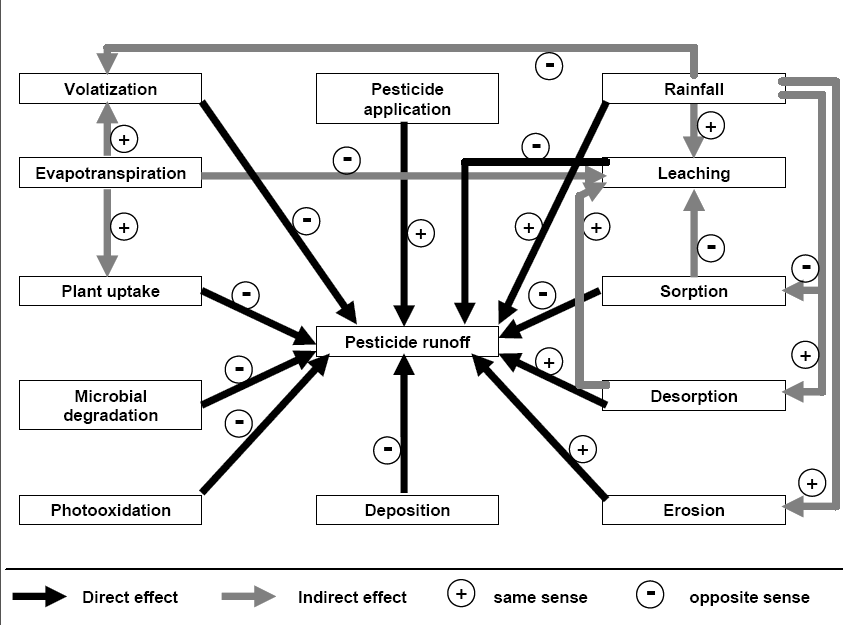6 Probabilistic approaches
Probabilistic approaches of modelling pesticide runoff are mainly based on existing models, which can be deterministic, hybrid, or empirical. Insofar, these approaches are not based on fundamentally new algorithms, but progress should be achieved by a higher certainty of model predictions compared to the common realistic worst case scenarios delivered by deterministic models. Apparently, probabilistic approaches represent a great progress compared to the calculation of single scenarios and might dominate future developments in modelling transport of pesticides via runoff. However in the following passages, we will also reveal some deficits of existing probabilistic methods.Tiktak et al. (2006) applied the metamodel EuroPearl, which is based on an analytical expression that describes the mass fraction of pesticide leached. The metamodel ignores vertical parameter variations and assumes transient flow and solute transport, Freundlich adsorption, first-order degradation, and passive plant uptake of pesticides. The calibration was carried out by calculating approximately 60,000 simulations done for 56 pesticides with different half-lives and partitioning coefficients. Thus, EuroPEARL was evidenced to be a suitable tool for probabilistic simulations, but its validation is still missing.
Shaaban and Elprince (1989) presented a hybrid pesticide leaching model that partly is of probabilistic nature: downward flow velocity and the diffusion coefficient D are selected with a Monte Carlo method from probability distributions given by mode, median and mean values. Contaminated depth is predicted as random variable and is highly sensitive to surface rates of recharge.
The latter study was performed on a small scale, but probabilistic approaches are supposed to be eligible for predictions of pesticide emissions on large scales, as it was evidenced by Franke and Teutsch (1994*). These authors applied a combination of LEACHM (Eckhardt and Wagenet, 1996) and a 3D-groundwater flow model to account for the spatial heterogeneity of an aquifer and found that hydraulic conductivity has only little effect on pesticide concentrations. However, this approach was created to estimate subsurface flow within the phreatic zone rather than to predict surface runoff of pesticides.
Surface runoff was modelled using a probabilistic approach by Huber et al. (1998). Runoff losses of pesticides were calculated by incorporating various spatial data sets on climate, soil, land use and other topics that have significant effects on pesticide runoff from fields. The lack of reliable information on the behaviour of pesticides under site-specific conditions constitutes the most important limitation of this approach.
Probabilistic approaches have been possible, since the recent development of computer hardware has allowed for calculating Monte Carlo simulations of elaborate numerical models within reasonable time spans. There have been two directions in the evolution of probabilistic approaches. The first relies on existing deterministic or hybrid models (Franke and Teutsch, 1994), while the second includes the development of new simple runoff models with less computational demands (Röpke et al., 2004*). The former approaches deliver geo-referenced pesticide concentrations or loads, but until present, these approaches are scarcely applicable to entire watersheds, because the computer hardware is still insufficient for such purposes. However, the newly developed condensed runoff models seem to fill the need of reliable predictions at large scales, yet the simplicity of these models neglects the complexity of partly interacting processes influencing pesticide loads in runoff (Figure 1*). Probably, future developments of computer hardware will enable the user to run Monte Carlo simulations of deterministic runoff models at large scales and thus, the condensed empirical and hybrid models will become redundant.
In general until present, the hypothesis remains unproven that probabilistic approaches deliver more reliable results than calculations of single runoff scenarios. Beulke et al. (2006*) investigated the reliability of results from probabilistic procedures in the leaching model PELMO. Different distributions of input parameters resulted in high variability of agreement between modelled and measured data. Beulke et al. (2006) concluded that subjective choices in Monte Carlo simulations may introduce large variability into probabilistic modelling. Therefore, results of probabilistic approaches have to be evaluated cautiously, also because stochastic approaches favour simple models with small predictive accuracy, in order to diminish computational effort of Monte Carlo simulations.





